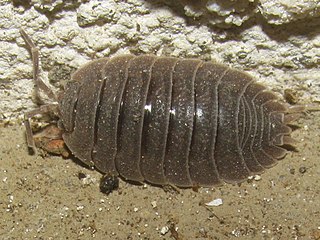
Isopoda is an order of crustaceans. Members of this group are called Isopods and include both terrestrial and aquatic species such as woodlice. All have rigid, segmented exoskeletons, two pairs of antennae, seven pairs of jointed limbs on the thorax, and five pairs of branching appendages on the abdomen that are used in respiration. Females brood their young in a pouch under their thorax.

Ligia oceanica, the sea slater, common sea slater, or sea roach, is a woodlouse, living in the littoral zone—rocky seashores of the European North Sea and Atlantic coastlines.

Beach wrack or marine wrack is organic material and other debris are deposited at high tide on beaches and other coastal area. This material acts as a natural input of marine resources into a terrestrial system, providing food and habitat for a variety of coastal organisms.
Ceratoserolis is a genus of isopods in the family Serolidae from the Southern Ocean around Antarctica and some Sub-Antarctic Islands. They prefer to live on soft bottoms and range of least between 24 and 950 m (80–3,120 ft) in depth. They are superficially similar to the unrelated, extinct trilobites and reach up to about 8 cm (3.1 in) in length. They were once considered to be part of the genus Serolis and for a long time only Ceratoserolis trilobitoides was recognized. The validity of the other species has been disputed, but there are some morphological and genetic differences between them and C. trilobitoides, and there are indications that additional, currently unrecognized species of Ceratoserolis exist.

Pentidotea wosnesenskii is a marine isopod which lives on seaweed on rocky shores along the British Columbia and Washington coastlines, as far south as San Francisco. It can often be found hiding under rockweed in the intertidal zone, and can be found in depths up to 919 metres (3,015 ft). It was described as Idotea wosnesenskii in 1851, by Johann Friedrich von Brandt, and is named after the Russian biologist Ilya G. Voznesensky. The isopod grows up to 4 centimetres in length and is usually green in colour.
Hemioniscus balani, a species of isopod crustacean, is a widespread parasitic castrator of barnacles in the northern Atlantic Ocean. Its range extends from Norway to the Atlantic coast of France, and as far west as Massachusetts. It is also commonly found on the Pacific coast of North America; it is not known if the Pacific and Atlantic populations are the same species, or if the Pacific population exists following human-assisted introduction.

Ligia is a genus of isopods, commonly known as rock lice or sea slaters. Most Ligia species live in tidal zone cliffs and rocky beaches, but there are several fully terrestrial species which occur in high-humidity environments.

Serolidae is a family of isopod crustaceans, containing the following genera :

Ligia exotica, also called sea roach or wharf roach, is a woodlouse-like isopod, a sea slater in the family Ligiidae. It is found in various parts of the world living on rocky coasts and harbour walls just above high water mark.

Ligia australiensis, the Australian marine slater, is a woodlouse in the family Ligiidae.

Ligia baudiniana is a woodlouse in the family Ligiidae. It has a coarsely granular surface and large eyes that are very close together.

Ligia cinerascens is a woodlouse in the family Ligiidae.
Ligia natalensis is a woodlouse-like isopod in the family Ligiidae.
Ligia cajennensis is a woodlouse in the family Ligiidae. It has a relatively narrow body with a rough, grainy texture. It's a dark yellow/rust color, with lighter antennae and legs. Its eyes are brownish black.
Ligia cursor is a woodlouse in the family Ligiidae.

Porcellio dilatatus is a species of woodlouse in the genus Porcellio belonging to the family Porcellionidae. This species is widespread in Europe, and has also been introduced to North America from Western Europe. They are 15 millimetres (0.59 in) long, are brown coloured and striped. They can be found feeding on alder leaves, but mostly feeds on organic food substrates, such as lettuce in the wild. It also feeds on inorganic metal salts.

Armadillidae is a family of woodlice, comprising around 80 genera and 700 species. It is the largest family of Oniscidea, and one of the most species-rich families of the entire Isopoda. Most of the armadillidae taxa are not monophyletic. Armadillids generally have a strongly convex body shape, with some rather shallowly convex. Like members of the woodlice family Armadillidiidae, armadillids are capable of enrolling into a sphere (conglobation), and are commonly known as pill bugs. Some species, however, have secondarily lost their conglobation ability. For example, a species exist in which the males lack the inner face of the coxal plates and are therefore unable to conglobate. Armadillids differ from the Armadillidiidae in that the antennae are fully enclosed within the sphere.

Anilocra capensis is a species of parasitic isopod in the family Cymothoidae. It is endemic to southern Africa. The species preferentially attaches itself to the hottentot seabream.

Deto echinata, the horned isopod, is a species of air-breathing isopod, or woodlouse, in the family Detonidae. It inhabits seashores in southern Africa and on some oceanic islands.
The Rocherpan Marine Protected Area is a small coastal conservation region on the West Coast of the Western Cape province, in the territorial waters of South Africa. It is about 25 km north of Velddrif on the road to Elands Bay, north of Dwarskersbos.














